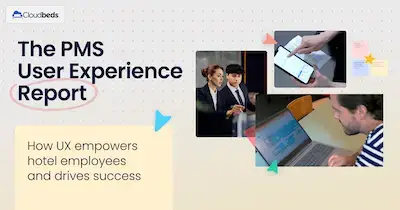How to build a group pricing
strategy to increase hotel revenue
Groups are a crucial revenue source for hotels, but they come with a caveat: if you don’t manage your group pricing strategy correctly, you could hurt your bottom line by leaving transient dollars on the table.
That’s why hotels must find a balance between these two segments and establish group pricing strategies like attrition clauses and block releases to protect revenue.
To help hoteliers understand the intricacies and best practices for group pricing, we spoke to Beth James, Product Solutions Manager at Cloudbeds and experienced Hotel Revenue Manager.
Why groups are important in hotel revenue management
As Beth explains, there are three reasons why groups have a place in a hotel’s revenue mix.
1. Help fill occupancy
Groups have longer booking windows, helping hotels secure business on the books. Beth says,

2. Offset low transient demand
Although transient business tends to be more profitable on a room-by-room basis, you can’t expect to bank on it all year long. With groups, you can offset seasonality and grow occupancy during historically slow times.
3. Contribute to higher total revenue
When factoring in more than just rooms, groups have a significant impact on total revenue. From AV rentals to meeting space and food and beverage – groups tend to spend much more (both contracted and ad-hoc) on property than your average transient traveler.
Types of group rates
All group rates come at a discount. How to calculate it, however, will depend on whether the rate is corporate or traditional.
Corporate rates.
“Corporate negotiated accounts are really a world on their own,” says Beth. Corporate rates can be set for meetings, incentives, conferences, and exhibitions (MICE) or on a contractual basis over a set period.
For MICE groups, guests check in and out on set dates, like with any other type of group. “These events will typically bring in a much bigger set of overnight guests, but will also need function space, increasing complexity,” says Beth.
The other type of agreement between hotels and businesses includes room allotments that the corporate account can book throughout the duration of the contract at a designated rate. As Beth explains, a safeguard clause may also be included in case the company doesn’t reach the number of agreed rooms.
With corporate agreements, hotels sell a large number of rooms, so rates tend to be lower than with other groups. Typically, the base for the negotiation is the standard fixed rate, which is the highest rate a hotel charges for a particular room category. “Discounts can go from 10% to 20% depending on the volume of business, seasonality, and the flexibility of the property,” explains Beth.
Traditional rates.
Traditional groups are tourist groups that book through agencies and SMERF (social, military, educational, religious, and fraternal). Depending on the group, hotels may need to provide function space and full F&B service. These groups tend to be smaller and to book closer to the date of stay. Also, they’re less likely to be repeat business. For these reasons, rates are usually higher than with corporate accounts.
The base for the negotiation is typically the BAR (best available rate), which is the most favorable rate available at a given time and fluctuates depending on the hotel’s dynamic pricing strategy. Beth says,

How to identify profitable group segments
To understand when group business is a profitable opportunity, Beth explains you need to look first at the total revenue potential. “That will depend on the group size and group rate and if they need more services. For example, a company meeting might need full-service F&B, meeting facilities, and AV equipment, so the negotiated rates will be higher,” she says.
The revenue opportunity should be evaluated on three factors:
1. Seasonality
If the dates are in a period where you know from historical data that you can reach the same occupancy with transient business, then accepting discounted group business would be discouraged.
2. Repeat groups
If it’s a repeat group, consider their history with you. Are they prone to cancellations? Do they spend a lot on property?
3. Level of complexity
More services command higher rates, but also increase operational costs and require more attention from hotel staff. Beth shares,

In order to weigh up all these factors in a systematic way and increase the chances of making the right decision, revenue managers can use a displacement analysis, which calculates the minimum group rate to apply to compensate for the loss of transient revenue.
Strategies to maximize group revenue
When done right, group business can be a game-changer for a hotel’s revenue management strategy. Beth advises that hotels look at groups as part of a wider distribution strategy:

She suggests different ways to do that on the groups side:
Understand your target segments.
Each type of group has different expectations, so it’s important to understand which groups make the most sense for your business. Once you do that, you can attract more profitable segments, win more deals, and deliver better group experiences that are sure to result in repeat business.
Don’t sell to groups over high-demand periods.
As Beth puts it, “If I was the revenue manager of a hotel in Times Square, I would never take a group over New Year’s Eve because I would know that I could sell to transient at extremely high rates.”
Transient business should take priority over groups in periods of historically high demand. Use groups to offset periods of low demand to capitalize on higher rates during peak seasons like summer and holidays.
Use attrition clauses.
Groups can boost occupancy overnight but also do great damage in case of cancellation. If a group cancels at the last minute, you’ll lose not only that revenue but also the one from transient guests who could have booked those rooms if they had been available.
You can mitigate that risk with an attrition clause which states that if the number of rooms used is less than what was originally booked, the hotel can charge a penalty. Hotels may also define the percentage or number of rooms that can be released ahead of time (with a predefined deadline) without the group incurring a fee.
Include block releases as failsafe.
Let’s say you agree to block an allotment of rooms that group members will be able to book individually at a discounted rate. With a block release clause included in the agreement, you can establish that all rooms that are not booked ten days before the check-in date, for example, will be released into general availability at the BAR rate.

As part of the Cloudbeds Platform, hoteliers can set auto-releases, which automatically return unsold rooms to the property inventory based on a predefined release schedule.
Establish parameters with your sales team.
The revenue management and sales teams should always be aligned, Beth says: “Sales should not be making rate decisions without consulting revenue management, but revenue management should provide sales with parameters, such as the minimum rate, to make better decisions.”
Both teams must work in tandem to attract groups and close deals while also ensuring maximum profitability.
Leverage benchmark data.
Getting as much insight as possible into the markets will help you make better pricing decisions. “STR, the hospitality benchmarking and analytics company, has a segmentation capability within their reporting that will tell you the ADRs for groups. However, unless you’re in a major market destination, it may not be available, as most properties aren’t segmenting their STR data,” says Beth.
Use LRA and NLRA as a negotiation tactic.
LRA (last room availability) groups will be able to book at the negotiated rate regardless of occupancy; for NLRA (non-last room availability) groups, when occupancy hits a certain threshold, rooms will no longer be available at the discounted rate, only at the BAR rate.
Both have advantages and disadvantages: with LRA clauses, you ensure consistent corporate business, but you may lose transient business, while NLRA clauses might deter some corporate clients who prefer guaranteed availability and consistent pricing.
Technology to support
Finally, Beth notes how revenue management systems (RMS) can be a great help to make informed group pricing decisions, thanks to their use of complex algorithms and historical data and their integration with the PMS.
However, she also warns that revenue managers are still crucial to interpreting the data, especially when it comes to groups, as they aren’t as predictable as transient business: “With groups, there are always external factors that come into play, things that can’t be predicted and force you to manually adjust your pricing strategy.”


















